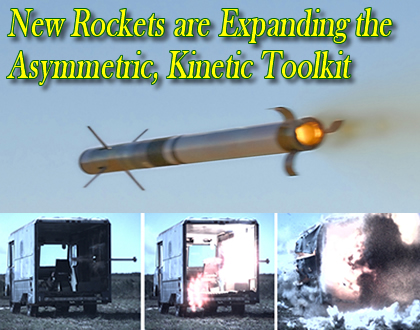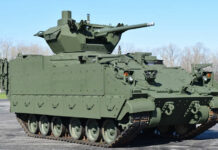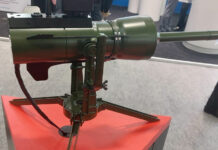
Since the beginning of operation Enduring Freedom in 2002 the use of stand-off precision attacks from manned, unmanned aerial systems as well as heavy artillery platforms were the weapon of choice for ‘kinetic’ attacks employed by coalition forces. Such weapons employed massive bombardments utilizing laser guided, and geo-targeted weapons, such as the 500 – 200 pound Paveway and JDAM weapons or massive guided multiple launch rocket systems (GMLRS). Such weapons carefully guided by forward observers, verifying that non combatants or friendly forces are affected were employed with high precision. However, each weapon, carrying warheads weighing hundreds to thousands of pounds of explosives, had an excessive ‘overkill’ effect on the targets, causing significant collateral damage.

Following repeated incidents of attacks, causing significant collateral damage to non-combatant civilians, new ISAF directives have restricted the use of ‘kinetic effects’ by the forces to the minimum, therefore limiting the operational flexibility of combat units. While such self-imposed restrictions are bound to receive a warm welcome from the civilian population, Taliban will undoubtedly exploit them in their operations.
New types of weapons, utilizing standard 2.75″ / 68mm or five inch Zuni rockets, modified into precision-strike weapons could enable commanders at all tactical levels to employ limited, precision kinetic effects, increasing deterrence and combat effectiveness, while risking minimal collateral damage, but having maximum effect on the target.
Although the development of such weapons was slow, lacking enthusiastic customer support, developers persisted in keeping programs alive and only recently the military are waking up to the reality, that a ‘small bang’ may be better than a ‘big bang’ that could totally derail a military campaign, due to excessive casualties or collateral damage, resulting in political pressure.
“Pilots in theater have expressed a desire for a guided rocket that hits the target and minimizes collateral damage,” said Jerry Brode, DAGR program manager at Lockheed Martin Missiles and Fire Control. “With multiple platform firings under its belt, along with the live warhead test we conducted at Eglin Air Force Base last year, DAGR is being qualified to deliver that capability.”
Lockheed Martin’s DAGR is one of the most mature laser guided 2.75″ rocket systems, developed by the company under a privately funded initiative. Recent firing trials involved AH-64D Apache helicopters and OA-6 Little Bird, hinting about interest from the U.S. Special Operations Command (SOCOM). The weapon has performed well in all guided firing tests, demonstrating precision strikes in 12 successful guided flight tests, hitting short- and long-range off-axis targets within minimal distance of the laser-designated aimpoint.
The Apache firing trials were conducted at the U.S. Army Yuma Proving Ground in March 2009, firing three rockets from the Apache; two successfully impacted the targets within minimal distance of the designated aimpoint. These tests marked the first airborne platform tests for DAGR, demonstrating its ability to engage targets in both day and night conditions.
Further tests were conducted in July 2009, also in Yuma, employing a Mission-Enhanced Little Bird helicopter test platform. The helicopter carried the DAGR in four-pack launch canister attached to the outboard rail of a modified XM299 launcher. The Little Bird firings were performed as a running fire, using a ground designator, and then self designation using the Little Bird’s onboard MX-15D1 targeting system. The DAGR rocket was extremely accurate in hitting the laser aimpoint in both tests.
DAGR is designed to be compatible with the Hellfire’s M299 family of launchers, offering potential integration on all rotary-wing platforms currently employing Hellfire missiles, including the Apache, Little Bird, Kiowa, Blackhawk, Cobra, and Tiger helicopters. A mixed loadout of Hellfire II and DAGRs can be mounted on the same launcher, providing operational flexibility that enables cost-effective multi-mission capability from a single platform.
The U.S. Marine Corps have indicated their requirement for a forward firing, low-cost precision guided weapon capable of accurately engaging fixed and moving targets in close proximity to friendly forces, while allowing firing aircraft to remain outside the threat envelope. The Corps are eying two different systems to convert existing stocks of 2.75″ Hydra II and 80mm Zuni unguided rockets into precision kill systems. To facilitate such capability the Naval Air Warfare Center Weapons Division (NAWCWD) has developed the WGU-58/B Guidance and Control system, to modify the Zuni rockets used by the Corps’ AV-8B, F/A-18s and AH-1W helicopter gunships.
The kit, developed by MBDA Inc., was recently tested in a successful live firing test employing a Semi-Active Laser Guided Zuni rocket at the U.S. Navy’s test facilities at China Lake, CA. utilizing the WGU-58/B Guidance and Control System. The WGU-58/B design maximizes use of off-the-shelf hardware and software, does not require changes to the aircraft interface, and attaches the WGU-58/B guidance and control kit to existing Zuni rockets. The upgrade can be performed at field level, permitting rapid transition of the hardware into the inventory. The rocket is fired from a LAU-10 pod launcher carrying four rockets. This capability dramatically increases the effective engagement capability of the aircraft and helicopter, as comparable weapons are carried only one or two per weapon station. Apart from MBDA Inc. (a subsidiary of the European missile group) and U.S. Navy China Lake facility, the NAWCWS industry partner team also includes Elbit Systems of America, General Dynamics and Honeywell.
In 2008 the U.S. Navy assumed control of the Advanced Precision Kill Weapon System (APKWS) development contract, currently at System Development and Demonstration (SDD) phase with BAE Systems demonstrating the guided rocket’s performance. Although the system performed a series of successful tests in 2007, the Army did not show much enthusiasm to transition the program into an operational weapon. The current funding allocated by the Marine Corps will be used for testing and qualification of the weapon for use on the Marine Corps’ AH-1W Super Cobra helicopter. BAE Systems’ Nashua facility plans to begin production of the upgraded rockets by the end of 2009.
Progress with 2.75″ laser guided rockets was also reported in Israel, with Elbit Systems and Alliant Techsystems performing a series of flight tests of the Guided Advanced Tactical Rocket (GATR). The platform used for the test firings was the BattleHawk armed Blackhawk helicopter, being evaluated by the Israel Air Force and Sikorsky. The guided rockets fired from the BattleHawk used lock-on before launch engagement profile, to engage an off-boresight target at a range of approximately three kilometers. The test validated flight worthiness, safe separation launch, and autonomous laser designated guided flight through a series of tests. The laser designated guided flight, launched from a standard 2.75 inch launcher, resulted in a direct impact on the target. The weapon also supports lock-on after launch as well as autonomous or remote laser designation firing modes.
In the past Raytheon has also competed for the APKWS after BAE’s win, the company decided to pull back from an independent development and opted to continue the program under an international cooperation with the Emirates Advanced Investments (EAI) of the United Arab Emirates (UAE). Under this cooperation the companies are developing the Laser-Guided Rocket (LGR) version for its 2.75″ Hydra II weapon. Earlier this year (2009) the weapon has completed a wind tunnel test that produced both high fidelity flight simulations and data for development of the aerodynamic model required for autopilot design. “This program is a potential model for Raytheon’s global business template,” said Richard Janik, Raytheon Missile Systems’ LGR program director. “It has important financial, engineering and manufacturing ramifications for our international business efforts, our UAE partner and our customers.” The Raytheon-EAI cooperative development agreement includes a follow-on production proposal to manufacture LGR in both the U.S. and the UAE. Similar international development programs are underway in Norway (by Nammo) and France (by Thales).



















